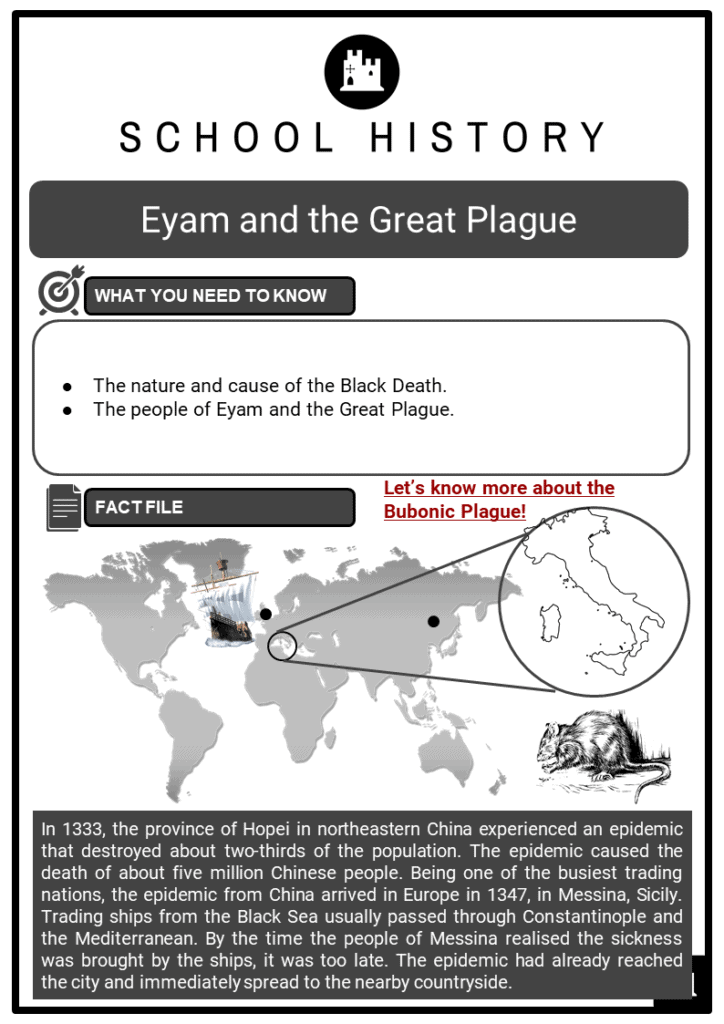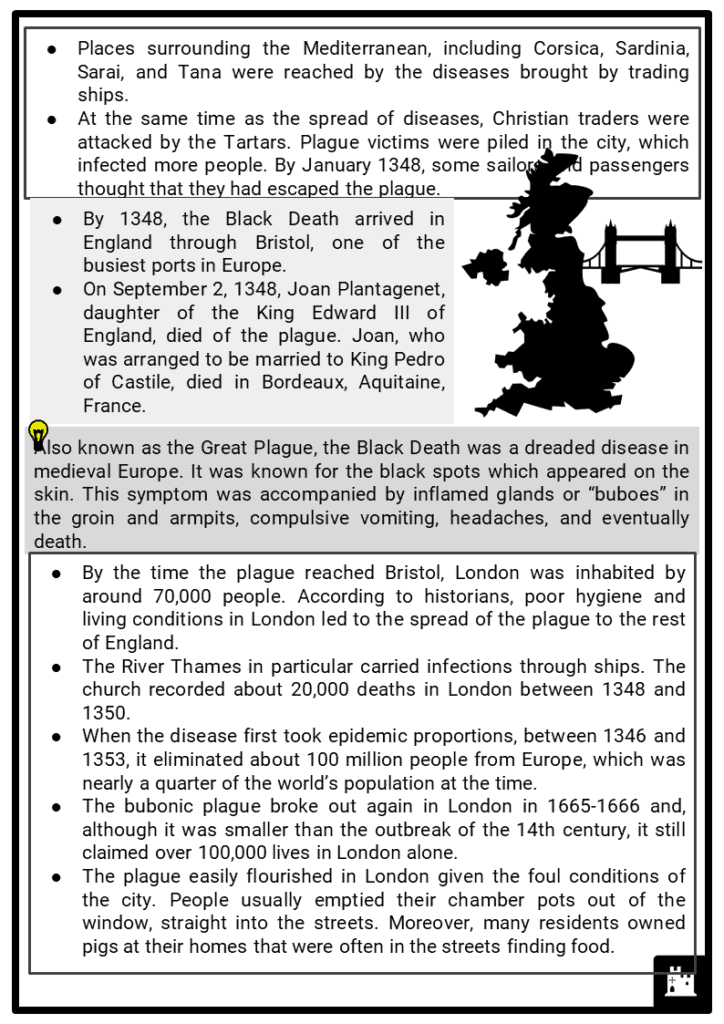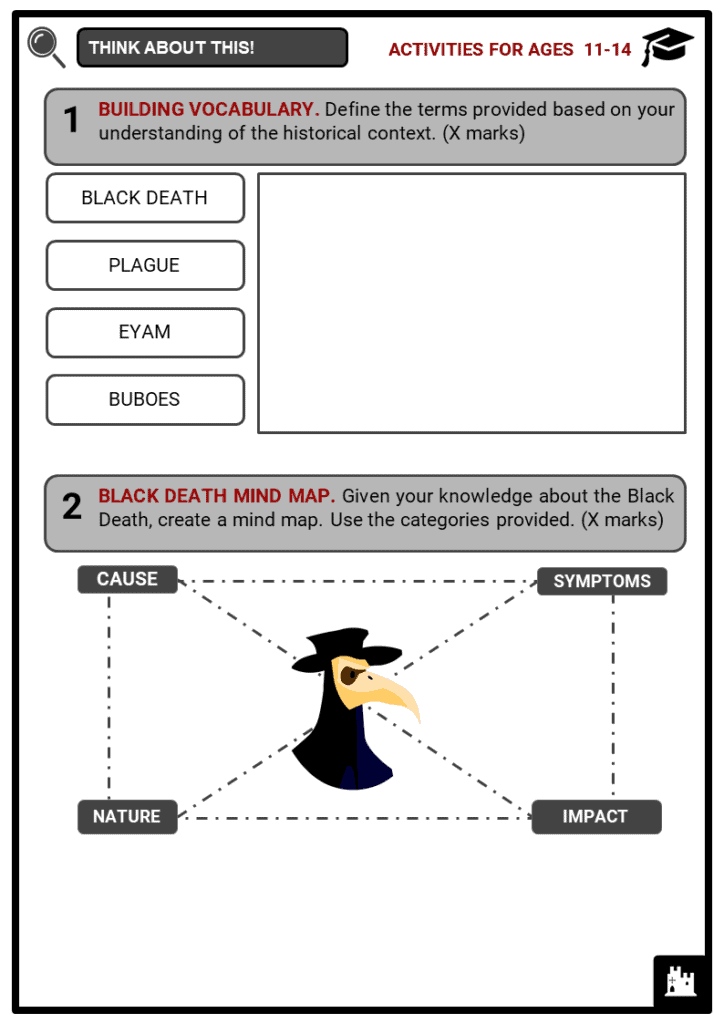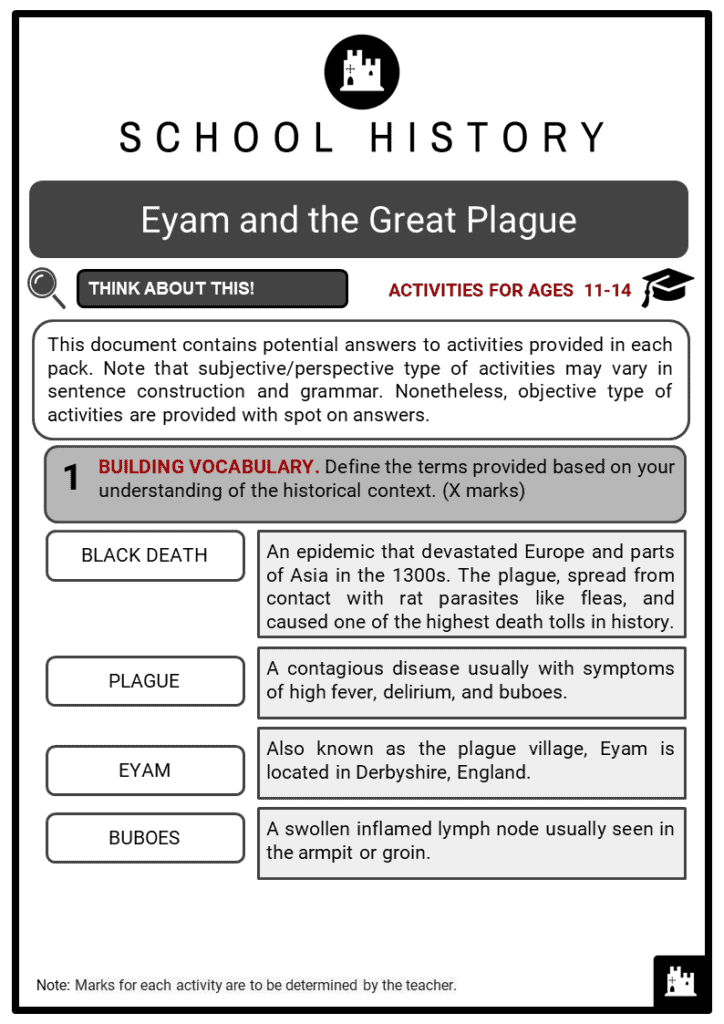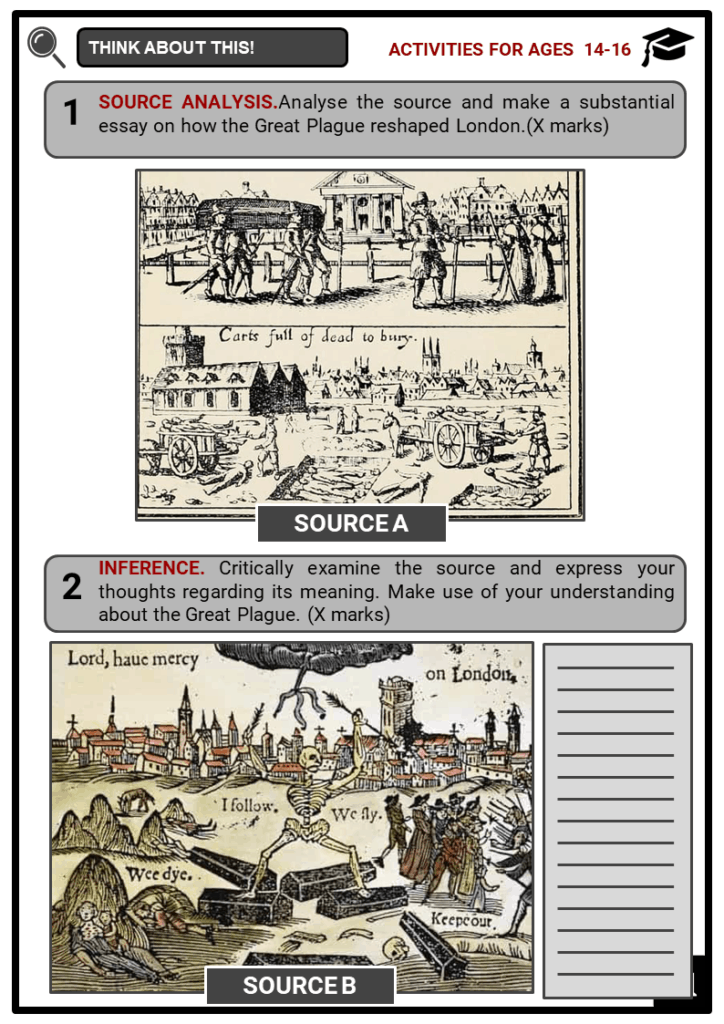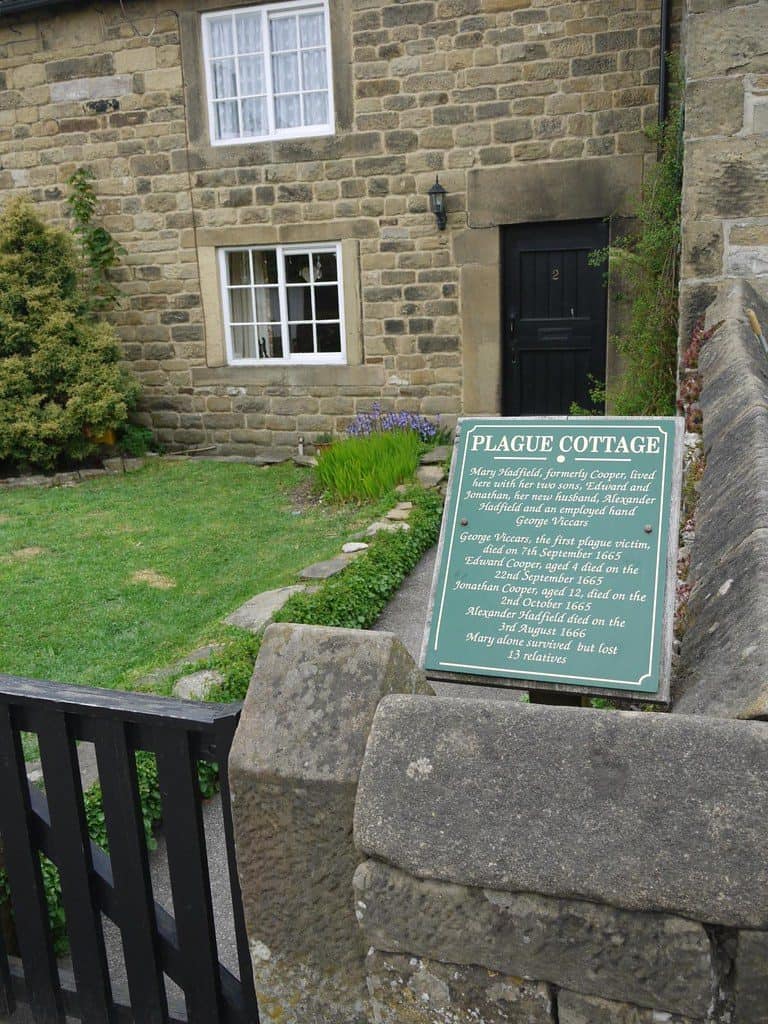Download Eyam and the Great Plague Worksheets
Do you want to save dozens of hours in time? Get your evenings and weekends back? Be able to teach Eyam and the Great Plague to your students?
Our worksheet bundle includes a fact file and printable worksheets and student activities. Perfect for both the classroom and homeschooling!
Table of Contents
Add a header to begin generating the table of contents
Summary
- The nature and cause of the Black Death.
- The people of Eyam and the Great Plague.
Key Facts And Information
Let’s know more about the Bubonic Plague!
- In 1333, the province of Hopei in northeastern China experienced an epidemic that destroyed about two-thirds of the population. The epidemic caused the death of about five million Chinese people. Being one of the busiest trading nations, the epidemic from China arrived in Europe in 1347, in Messina, Sicily. Trading ships from the Black Sea usually passed through Constantinople and the Mediterranean. By the time the people of Messina realised the sickness was brought by the ships, it was too late. The epidemic had already reached the city and immediately spread to the nearby countryside.
- Places surrounding the Mediterranean, including Corsica, Sardinia, Sarai, and Tana were reached by the diseases brought by trading ships.
- At the same time as the spread of diseases, Christian traders were attacked by the Tartars. Plague victims were piled in the city, which infected more people. By January 1348, some sailors and passengers thought that they had escaped the plague.
- By 1348, the Black Death arrived in England through Bristol, one of the busiest ports in Europe.
- On September 2, 1348, Joan Plantagenet, daughter of the King Edward III of England, died of the plague. Joan, who was arranged to be married to King Pedro of Castile, died in Bordeaux, Aquitaine, France.
- Also known as the Great Plague, the Black Death was a dreaded disease in medieval Europe. It was known for the black spots which appeared on the skin. This symptom was accompanied by inflamed glands or “buboes” in the groin and armpits, compulsive vomiting, headaches, and eventually death.
- By the time the plague reached Bristol, London was inhabited by around 70,000 people. According to historians, poor hygiene and living conditions in London led to the spread of the plague to the rest of England.
- The River Thames in particular carried infections through ships. The church recorded about 20,000 deaths in London between 1348 and 1350.
- When the disease first took epidemic proportions, between 1346 and 1353, it eliminated about 100 million people from Europe, which was nearly a quarter of the world’s population at the time.
- The bubonic plague broke out again in London in 1665-1666 and, although it was smaller than the outbreak of the 14th century, it still claimed over 100,000 lives in London alone.
- The plague easily flourished in London given the foul conditions of the city. People usually emptied their chamber pots out of the window, straight into the streets. Moreover, many residents owned pigs at their homes that were often in the streets finding food.
- With the increasing death toll, the Smithfield cemetery was hurriedly opened by the Bishop of London. In addition, a secondary cemetery was opened at Spittle Croft. The same year, Edward III ordered the cleaning of the streets of London to further avoid contamination, however the council replied that street sweepers and cleaners had died of the plague.
Scientific explanation of the plague
- According to scientists today, the Black Death was caused by the spread of a bacillus called Yersinia pestis (named after Alexandre Yersin, a French biologist who discovered the bacterium in the 19th century). Many small mammals such as rats, rabbits, and squirrels can host the bacteria. In the case of England, rats populated the streets and houses.
- Scientists discovered that the fleas Xenopsylla cheopis hosting on rats caused the plague to spread to humans. The transmission occurs through inhalation of infected droplets or direct contact with the blood of infected animals and humans.
The people of Eyam during the Great Plague
- On September 7, 1665, the village of Eyam was hit by an epidemic of bubonic plague. Eyam was a civil parish in Derbyshire Dales. It was founded by Anglo-Saxons after the Roman era. A small town of a few hundred inhabitants made perhaps the most heroic undertaking in history: instead of fleeing the Great Plague, they all decided to stay in the town in order to prevent the infection from spreading further.
- It all started with cloth. The plague reached the village of Eyam (in Derbyshire, 35 miles southeast of Manchester), in the summer of 1665, when a London merchant sent flea-infested fabrics to the village tailor, Alexander Hadfield. The tailor’s assistant, George Viccars, was the first one to receive the fabrics.
- Viccars noticed that the cloth was damp and attempted to dry it by spreading it out it in front of his fireplace. The unfortunate man had not noticed that fleas had created a nest inside of it. These fleas were not on their own either – they were carrying the bacteria of the bubonic plague.
- This was how the village of Eyam was struck by the Black Death. Viccars was the first person in the small British town to be struck by the disease and die.
- Then, the contagion began to rapidly spread to the rest of the village causing great panic and upheaval. The citizens were scared and felt threatened by the sickness.
- Their initial intention was to flee the city to save themselves. However, two local pastors, William Mompesson and Thomas Stanley, intervened.
- It was a difficult decision to accept, but with their authority they managed to convince their fellow villagers that the best thing to do was to stay.
- Therefore, they shut the gates of the city until the plague was over. The two religious authorities stated that it was their duty as Christians to stop the plague, no matter the price, as God would reward them for their sacrifice.
- With the villagers convinced, the town cut off all communication with its neighbours: no one could leave and no one could enter. Meanwhile, people inside the village died in high numbers. Food, water, and other basic necessities were sent from the countryside.
- Of the 350 original inhabitants, only 90 survived. That year, no household was spared. The wife of Mompesson, the priest who asked everyone to stay, also died. But when the disease stopped spreading, Eyam’s goals had been achieved and the plague stopped spreading. The Great Plague that spread from London affected many places in England.
- No other town or village acted in the same way as Eyam, however. Today it is remembered for the heroic sacrifice made by its inhabitants.
- Stones were placed around the outskirts of the village to indicate that people should not go beyond that point. All Eyam residents – even those who were in good health – vowed not to leave until the disease had run its course.
- The village received food and help from other neighbouring villagers who left parcels of meat, grains, and other items on the outskirts of the town. In return, the residents of Eyam left coins in a bowl filled with vinegar and water as it was believed that vinegar acted as a disinfectant. The stones around the village still exist and can be viewed today.
- Aside from being quarantined, villagers also took steps to minimise the spread of infection within the village. The church was moved to another location, which was far from the cemetery, and families were required to bury their own dead.
- Many surviving members experienced the trauma of burying their entire family, the priest Mompesson was no exception. Sometimes, bodies were dragged into the street by tying ropes around the victim’s feet to avoid contact with the deceased.
- After 14 months, the plague disappeared abruptly by which time 260 villagers of the original 350 were dead.
- Today, there are plaques, signs, and memorials all over the village and the last Sunday of every August is known as Plague Sunday – a memorial service held in Eyam.
Image sources:
[1.] https://live.staticflickr.com/4050/4681019043_a4081aa3e9_b.jpg

